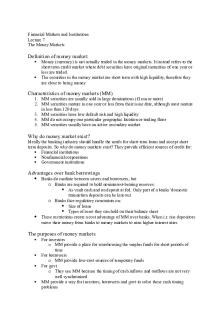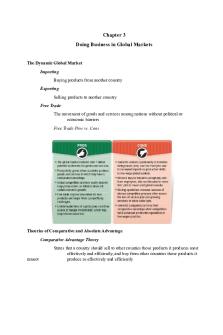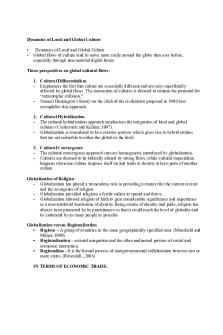Lecture 4-Cultural Dynamics in Assessing Global Markets PDF

| Title | Lecture 4-Cultural Dynamics in Assessing Global Markets |
|---|---|
| Course | International Business |
| Institution | University of Washington |
| Pages | 4 |
| File Size | 111.1 KB |
| File Type | |
| Total Downloads | 26 |
| Total Views | 123 |
Summary
Understanding culture and its place in business. ...
Description
Cultural Dynamics in Assessing Global Markets Wednesday, April 10, 2019
10:48 AM
The Importance of Cultural Sensitivity in Business Dealings An ignorance of a country's cultural norms can… Offend your customers Alienate employees in other countries Lead to a reduction of product or service sales Poor image beyond the market Ex: Toyota offends Chinese customers through ads Dolce & Gabbana offends Chinese by assuming they ONLY know how to use chopsticks What is Culture? Culture is the sum of the "values, rituals, symbols, beliefs, and thought processes that are learned, shared by a group, and transmitted from generation to generation" Culture drives so much of what we thing The Self-Reference Criterion: When confronted with a set of facts, we react spontaneously on the basis of knowledge assimilated over a lifetime - Knowledge is a product of the history of our culture - Our cultural references can be unique and powerful in driving our thoughts and action, eg. Music that drives powerful emotions - Culture is not part of your DNA, it is something you learn Ex: our favorite food is different than another countries Fun activities depend on what we are used to based on geography Much of early culture was based on mythology - Mythology (story-of-the-people) is sacred tales of a culture - Myths express the beliefs and value about these subjects held by a certain culture - Cultural heroes are characters that have changed the world through invention and discovery ○ EX: Thor's Hammer, found in car headlights - Uncle Sam is a popular symbol of the US government in our culture Culture's Pervasive Impact - Culture influences every part of our lives - Food, carbs differ by culture Geography as a Driver of Culture
Geography as a Driver of Culture - Japan's geography has influenced their culture because it was hard to invade and therefore, not a lot of outside cultures penetrated through Japanese borders ○ Being an island, fish was important to their diet - Indonesia has so many islands and multiple mountain ranges further isolating people from each other ○ As a result, Indonesia is an incredibly, ethnically, diverse country, with around 300 distinct native ethnic groups ○ More than 742 different languages are spoken ○ Wanted to find a national language and chose Indonesia, used in media, government, schools, workplaces, and the upper-class ○ This unified Indonesia's economy and became the largest in Southeast Asia ○ They still have many cultures that often conflict ○ Uniting the multicultural groups have both good and bad consequences - The Black London Taxi was a cultural icon in England ○ The company wasn't doing well, they were bought out and are attempting to reestablish their dominance, such as creating an electric British taxicab ○ However, Uber is a main competitor in London ○ The test London cabbies have to pass is incredibly difficult, but is challenged by GPS ○ Disruptive technology can quickly devastate existing industries, cultural icon or not § Lawsuit between Uber and the London government with London trying to keep Uber out to support the London cabbies How do we begin to understand a market and its unique culture? - The stronger the local religion, icons, or ties to history are, the harder it can be to bring new businesses to these markets - Sports is a key driver of globalization but business still needs to operate to local markets and their sport preference - Countries have fundamental differences in cultural values which influences various types of business and market behavior Hofstede Cultural Dimensions: the effects of a society's culture on the values of its members, and how these values relate to behavior The Power Distance Index measures power inequality between superiors and subordinates within a social system - Cultures with high PDI scores tend to be hierarchical and value power and social status - Cultures with large power distance, such as those in Latin America or Asia, are cultures that have clear distinctions between superiors and subordinates
Individualism/Collectivism Index - Individualism culture reflects and "I" mentality, they reward individual initiative - Collectivism cultures reflect a "we" mentality and subjugate the individual to the group Masculinity vs. Femininity Index - Femininity represents "a preference for cooperation, modesty, caring for the weak and quality of life" - Masculinity defined as "a preference in society for achievement, assertiveness and material rewards for success" Uncertainty Avoidance Index - Measures the tolerance for uncertainty in a society - Weak UAI cultures are associated with a low level of anxiety and stress, a tolerance of deviance and dissent, and a willingness to take risks - Strong UAI cultures experience anxiety and stress and accord a high level of authority to rules as a means of avoid risks Long-Terms vs Short-Term Orientation - Short-term orientation indicates that traditions are honored while steadfastness is valued - Long-term oriented views adaptation and circumstantial, pragmatic problem-solving and the most important events in life will occur in the future Indulgent vs. Restraint Index - Indulgence is a society that allows relatively free gratification of basic and natural human desires related to enjoying life and having fun - Restrained societies control gratification of needs and regulate it by means of strict social norms Using the Hofstede Model to Explore Chinese Culture Power Distance - believes inequalities amongst people are acceptable, there is no defense against power abuse by superiors Individualism - a highly collectivist culture, act as a group Masculinity - success oriented and driven, leisure time is not important Uncertainty Avoidance - comfortable with ambiguity, Chinese and adaptable and entrepreneurial Indulgence - have a tendency to cynicism and pessimism, restrained societies do not put much emphasis on leisure time Long Term Orientation - Chinese show an ability to adapt traditions easily to changed conditions, a strong propensity to save and invest, thriftiness, and perseverance in achieving results Examples of Cultural Differences in Business
Space - Different cultures have varying expectations about personal space and physical contact Context - Low-context cultures such as the US and most of Europe require little to no explanation of orders and requests - High-context cultures such as most Eastern and South American populations expect much more explanation about orders and directions Cues - The word "yes" usually means agreement in Western cultures - In Eastern and high-context cultures however, the word "yes" may mean that the party understands the message, not that he agrees with it Examples: - Joes Biden is in trouble for not minding personal space, in France its normal - Bowing in Japan is a gesture of respect, Obama did but Trump did not - Japanese managers may shift from one function to another every year Rituals and Symbols Rituals are patterns of behavior and interaction that are learned and repeated - Eating dinner at 6pm vs 10pm - Chinese zodiac animals and what they represent The "stop" sign is very similar in many countries, globalized by necessity - The color red means different things in different cultures Beliefs Beliefs, which mainly stem from religious training, vary culture to culture - Western culture doesn’t like the number 13, China doesn't like 4...
Similar Free PDFs

Global competitive dynamics
- 2 Pages

Chapter 7 Serving Global Markets
- 38 Pages

3a Dynamics - Lecture 3
- 24 Pages

Government Actions in Markets
- 5 Pages

Amazon in Emerging Markets Case
- 41 Pages

FMI Lecture 7 Money markets
- 7 Pages
Popular Institutions
- Tinajero National High School - Annex
- Politeknik Caltex Riau
- Yokohama City University
- SGT University
- University of Al-Qadisiyah
- Divine Word College of Vigan
- Techniek College Rotterdam
- Universidade de Santiago
- Universiti Teknologi MARA Cawangan Johor Kampus Pasir Gudang
- Poltekkes Kemenkes Yogyakarta
- Baguio City National High School
- Colegio san marcos
- preparatoria uno
- Centro de Bachillerato Tecnológico Industrial y de Servicios No. 107
- Dalian Maritime University
- Quang Trung Secondary School
- Colegio Tecnológico en Informática
- Corporación Regional de Educación Superior
- Grupo CEDVA
- Dar Al Uloom University
- Centro de Estudios Preuniversitarios de la Universidad Nacional de Ingeniería
- 上智大学
- Aakash International School, Nuna Majara
- San Felipe Neri Catholic School
- Kang Chiao International School - New Taipei City
- Misamis Occidental National High School
- Institución Educativa Escuela Normal Juan Ladrilleros
- Kolehiyo ng Pantukan
- Batanes State College
- Instituto Continental
- Sekolah Menengah Kejuruan Kesehatan Kaltara (Tarakan)
- Colegio de La Inmaculada Concepcion - Cebu









